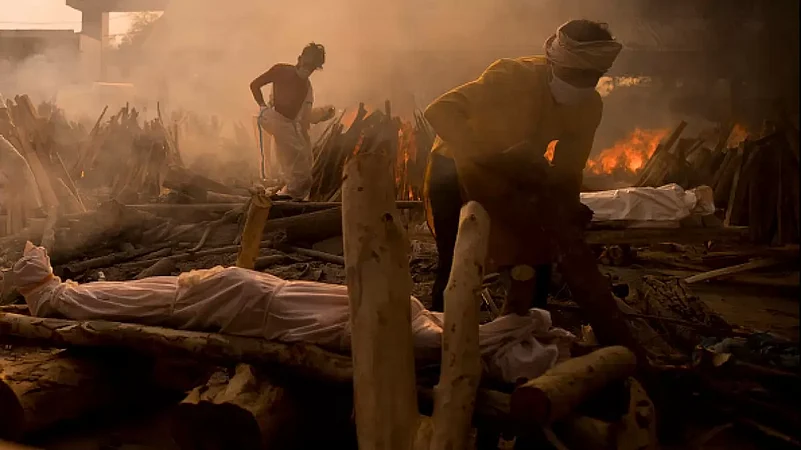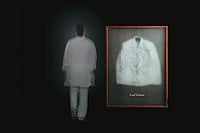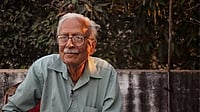Occasionally, one comes across a work of creative imagination which packs in a harder punch to than the grotesque reality itself it endeavours to reproduce. The ones who achieve this feat do so by amplifying reality through identifying the contradictions hidden in the nooks and crannies of the socio-political tensions that aren’t so apparent to the mass consciousness. This amplification may appear as theatrical to many. But the theatrical or the dramatic in literature and arts does not necessarily drive us away from the real. On the contrary, quite often, it serves as a trusted assistant to the otherwise tough to demonstrate, elusive shades of the real, as it does in the case of Pravin Kumar’s debut novel Amar Deswa.
Like his earlier, and repeatedly awarded, long short stories “Ek Raja Tha Jo Sitafal se Darta Tha”, “Vasco de Gama ki Cycle” and “Lal Calcutta”, this novel also strives to present a narrative of the ‘citizen subject’ caught between the Scylla and Charybdis in the compulsion to exercise her ‘agency’ to control the conditions of her existence, and the callous approach of the ‘system’ towards the recognition of the same. Caught between the two, the characters in the world of Amar Deswa, most distinctly the lawyer S. Amrit, and Doctor B. P. Mandal, endeavour to navigate through what the author himself addresses as “the uncanny labyrinth of the System.”
The 'System' in the novel is the prime mover of the narrative, and the characters function as the illustrations of the Janus faced “discourse on citizenship” (again, author’s own expression). Aghori Bazzar as a location supplies the novel with a spatial anchorage, and being as such, stands in line with Rahi Masoom Raza’s Katra Bi Arzu, Abdul Bismillah’s Zheeni Zheeni Bini Chadariya, and Kashinath Singh’s Kaashi Ka Assi, to name a few, the novels where locations define close-knit communities, enabling the articulation of tensions, as the plot complicates, far intricate and intense. Amar Deswa uses this time-tested technique with extreme care to equally edifying ends.
The characters in the novel are also congenitally related through the location, Aghori Bazar. Even an outsider couple (as we learn later) like Rajat and Isha do not feel like outsider while we stay inside the limits of the narrative. On the other hand, as the plot thickens, the narrator resurrects the character Kajrauta for example, who had left the locale long ago but retained his presence in the demographic vividness of the Bazar through memories of the other characters. Hence his return is experienced, both by the reader and the Kajrauta himself, more as rehabilitation than the forced migration back to home and the hearth due to the unemployment crisis born of pandemic.
The plot in the novel takes some time to pick pace, and the staggered pace seems to be a conscious decision of the author. Concerned primarily, as pointed above, with the “discourse on citizenship embroiled in the labyrinth of system” he gives his major characters, S. Amrit and Dr. Mandal—but also comparatively lesser characters like Dr. Mandal’s compounder Ramayan and the Japanese Professor Hoshigawa—ample space to detail the coordinates of his pivotal discursive concerns. The narrator does not even hesitate to enter directly as a commentator and take command of the direction of the discourse where he senses his characters confounded.

It is the onset of the pandemic that swishes the narrative ahead, and as the crisis gradually deepens the reader finds herself suddenly drawn into it with a hurtling combination of antithetical forces. As the pandemic precipitates the crisis in Aghori Bazar and exposes the rag-tag condition of the governmental health and other supporting infrastructures, the characters also acquire roundness, exposing the classical dialectics between moral and immoral choices, as Spinoza delves in his tracts on ethics. This happens to be one of the most complex aspects of storytelling and the author manages to demonstrate both the sides of the human nature—its self-aggrandizing, Volponish one as well as its humanness—without falling into the trap of essentialism.
For example, mid-way the narrative when the outbreak is just about to set in, Ramayan decides to abandon Dr. Mandal’s idealism in exchange for a mercenary health facility (an astute illustration of the most abominable and unscrupulous tactics that the private health care facilities in small-town India resorted to in order to harvest the maximum yield from the collapse of governmental health care facilities) yet he ensures that the Muslim medical representative, Rajat, living in hiding in Aghori Bazar gets a bed in the hospital in the Math, even though it involves a high personal risk. The author does not condemn Ramayan or forget him; he is careful to demonstrate the survival of some humanity even in characters who would have been reduced to carrions and vultures in the hands of lesser authors.
As the novel moves towards the denouement, the affective charge rises to a heart-rending crescendo. Death of Dr. Mondal’s son, and the mayhem we evocatively experience in Banaras, leaves the reader shell-shocked and numb, not quite unlike Dr. Mandal himself. The victims of the pandemic seem to have degenerated into spoils of a siege, to be en-cashed all the way to the funeral pyre. One genuinely feels sorry for the absence of the magical healing touch of the Mahatma from the author’s story “Lal Culcutta”.
The Hoshigava manuscript and the related fable remains open to interpretation, and the author seems to have kept it so by choice. The core, the theme of the power struggle between the governor and the governed, is a constant throughout the recurring, intermittent telling and retelling of the fable (which author and Hoshigava both, insistently, on several occasions, present as a legend rather than a fable) that adds the element of the mystique—yet another feature which is in common with the author’s above mentioned long stories.
What lends the legend even more character (and undisclosed potential) is the strong hints of a direct connection between the real characters in the novel, like Kajrauta, S. Amrit, Hoshigava etc. with the fabulous Cheetah, with its back covered in bat skin. The blending lends the fabulous the quality of quasi–Magical Realism, which has been the signature of the author in his works mentioned at the beginning of this review.
Taken in totality, the novel has a neat flow and exceeds the promise that the title or the subtitle “the uncanny labyrinth of the System” hands out to the reader. Though one does feel at the end that the tortuous “uncanny labyrinth” that exhausted Dr. Mandal and even the seemingly indefatigable S. Amrit, ended up taking a toll on the forbearance of the author as well, and prompted him to conclude the narrative abruptly. It only leaves the reader high and dry and in search of a closure.
However, the author’s choice to keep the novel open ended keeps the scope open for picking up the inconclusive strands of the narrative and developing them into full-fledged narratives later. I hope the author would oblige his readers eventually.
(Pravin Kumar Associate Professor Department of English Satyawati College, University of Delhi)























